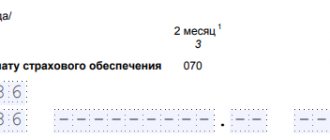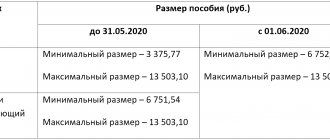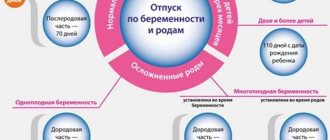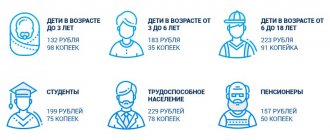How the “Direct Payments” project works Algorithm for assigning and paying benefits Step 1. The employer receives documents from the employee If in the “pilot” region the LN is paper If in the “pilot” region the LN is electronic Step 2. The employer calculates the benefit and pays the amount for the first three days Step 3. The employer prepares and sends documents to the Social Insurance Fund Step 4. The Social Insurance Fund checks the documents and assigns benefits Step 5. The Social Insurance Fund pays benefits Reporting Calculation of 4-FSS contributions 2-NDFL certificates for employees How to prepare for the transition to the “Direct Payments” project How to reimburse from FSS amount of excess expenses How to reimburse from the FSS expenses for financial support of preventive measures
The Direct Payments project started in 2011. Now there are already 69 regions in it, and by the beginning of 2021 another 16 will join. The full list of participants is given in Decree of the Government of the Russian Federation dated April 21, 2011 No. 294.
How does the Direct Payments project work?
Now the FSS works with policyholders on an offset principle: the employer pays benefits, and he transfers the difference between the amounts of accrued insurance premiums and paid benefits to the Fund.
In the “Direct Payments” project, policyholders must pay compulsory social insurance contributions in full; they cannot be reduced by the amount of expenses incurred by the Social Insurance Fund.
The procedure for interaction between the Social Insurance Fund, employer and employee is also changing. The company receives an application and documents for payment of benefits from the employee, sends them to the FCC electronically, and the Fund directly pays benefits to the insured employee. At the same time, the calculation principle and the amount of benefits do not change.
The new rules apply to the payment of the following benefits:
- temporary disability benefits (including in connection with an industrial accident or occupational disease);
- maternity benefits;
- a one-time benefit for women registered in medical institutions in the early stages of pregnancy;
- lump sum benefit for the birth of a child;
- monthly child care allowance;
- payment of leave to a person injured at work (in addition to annual paid leave).
Julietta Anatolyevna Ustova, manager of the branch of the State Institution - the regional branch of the FSS of the Russian Federation for the Kabardino-Balkarian Republic, talks about the advantages of the pilot project:
“The new procedure allows citizens to receive the benefits due to them by law in a timely manner and in full, regardless of the financial situation of the employer. The policyholder does not need to withdraw funds from circulation to pay them. The calculation and transfer of benefits will now be carried out not by the enterprise’s accounting department, but by the regional branch of the Social Insurance Fund. This eliminates incorrect calculation of benefits, reduces labor costs and simplifies reporting. Insurance contributions for compulsory social insurance are not reduced by the amount of expenses incurred. Employers pay them to the Fund in full.”
Regulations
- Decree of the Government of the Russian Federation of April 21, 2011 No. 294, as amended. dated 11/13/2019;
- Art. 431 of the Tax Code of the Russian Federation (as amended by Article 9 of the Federal Law of November 30, 2016 No. 401-FZ), valid from January 1, 2020;
- Application form for the assignment of benefits - order of the Federal Social Insurance Fund of the Russian Federation dated November 24, 2017 No. 578;
- Form of the electronic register of information - order of the FSS of the Russian Federation dated November 24, 2017 No. 579;
- Order of the Ministry of Health of the Russian Federation dated September 1, 2020 No. 925N;
- Order of the Ministry of Health and Social Development dated July 11, 2011 No. 709n.
A Draft Decree of the Government of the Russian Federation No. 00110475 has also been developed. It approves the specifics of the appointment and payment by territorial bodies of the Social Insurance Fund of the Russian Federation of benefits for temporary disability, injuries, pregnancy and childbirth, one-time child benefits, as well as the procedure for reimbursement of expenses to policyholders for the payment of social benefits and for preventive measures to reduce industrial injuries and occupational diseases.
For example, when an insured event occurs, they plan to refuse to ask employees for an application for payment of benefits and a complete list of documents for assignment, as is done now. Instead, the employee will provide only those documents that the policyholder does not have. If the project is accepted, women on maternity leave will no longer have to apply for benefits.
FSS pilot project in 2021
Reform of the social insurance system began on July 1, 2011.
Previously, in all regions of the Russian Federation, benefits to insured persons were paid by the employer and the amount of insurance premiums accrued to them was reduced. But then the country began to gradually switch to direct payments of Social Security benefits. During the period 2012-2020. the rules for financing benefits in the pilot project were determined by Decree of the Government of the Russian Federation dated April 21, 2011 No. 294. The chronology of regions joining the project is as follows:
- Karachay-Cherkess Republic and Nizhny Novgorod region (from 01/01/2012 to 12/31/2020);
- Astrakhan, Kurgan, Novgorod, Novosibirsk, Tambov regions and Khabarovsk Territory (from 07/01/2012 to 12/31/2020);
- Republic of Crimea, Sevastopol (from 01/01/2015 to 12/31/2020);
- Republic of Tatarstan, Belgorod, Rostov and Samara regions (from 07/01/2015 to 12/31/2020);
- Republic of Mordovia, Bryansk, Kaliningrad, Kaluga, Lipetsk and Ulyanovsk regions (from 07/01/2016 to 12/31/2020).
- Republic of Adygea, Republic of Altai, Republic of Buryatia, Republic of Kalmykia, Altai and Primorsky territories, Amur, Vologda, Magadan, Omsk, Oryol, Tomsk regions and Jewish Autonomous Region (from 07/01/2021 to 12/31/2020);
- Kabardino-Balkarian Republic, Republic of Karelia, Republic of North Ossetia - Alania, Republic of Tyva, Kostroma and Kursk regions (from 07/01/2018 to 12/31/2020);
- Republic of Ingushetia, Republic of Mari El, Republic of Khakassia, Chechen Republic, Chuvash Republic, Kamchatka Territory, Vladimir, Pskov and Smolensk regions, Nenets and Chukotka Autonomous Okrug (from 01/01/2019 to 12/31/2020);
- Trans-Baikal Territory, Arkhangelsk, Voronezh, Ivanovo, Murmansk, Penza, Ryazan, Sakhalin and Tula regions (from 07/01/2019 to 12/31/2020);
- Komi Republic, Sakha Republic (Yakutia), Udmurt Republic, Kirov, Kemerovo, Orenburg, Saratov and Tver regions, Yamalo-Nenets Autonomous Okrug (from 01.01.2020 to 31.12.2020);
- Republic of Bashkortostan, Republic of Dagestan, Krasnoyarsk and Stavropol territories, Volgograd, Irkutsk, Leningrad, Tyumen and Yaroslavl regions (from 07/01/2020 to 12/31/2020).
Participation in the FSS pilot project was mandatory for all employers in the specified regions; they did not have the right to choose.
Since 2021, the pilot project has been extended to the entire territory of the Russian Federation. The financing rules are now established by Government Resolution No. 2375 dated December 30, 2020. From 2022, this procedure is planned to be made permanent.
Algorithm for assigning and paying benefits
We will step by step consider the actions of an accountant to assign and pay benefits to an employee.
Step 1. The employer receives documents from the employee
When the employee brings documents confirming entitlement to benefits, check that they are correct. For example, sick leave must have been issued no earlier than six months ago.
Then prepare an application to the Social Insurance Fund in the form established by Social Insurance Fund Order No. 578 dated November 24, 2017. It is required for all insurance cases, including for periods of temporary disability. The employer can generate and print such a statement for the employee and give it to him for verification. The employee will check the details for transferring funds (bank account, postal address) and personally sign the application.
“The insured person can choose a convenient way to receive benefits: to a bank account, by postal transfer or to a Mir payment card with a 16- or 19-digit number. Benefits can be transferred to the employee either to the salary account or to any other,” says Natalya Vladimirovna Matveeva.
“The account must have 20 digits, match the bank’s BIC and be registered specifically to the employee. At the same time, it is possible to transfer benefits using only one detail - the Mir payment card number,” adds Julietta Anatolyevna Ustova.
From January 1, 2021, the following will be mandatory transferred to Mir cards:
- maternity benefits;
- a one-time benefit for women who registered with medical organizations in the early stages of pregnancy;
- lump sum benefit for the birth of a child;
- monthly child care allowance;
- payments to citizens exposed to radiation as a result of the disaster at the Chernobyl nuclear power plant,” as a result of the accident at the Mayak production association and the discharge of radioactive waste into the Techa River and as a result of nuclear tests at the Semipalatinsk test site.
After January 1, 2021, banks will check the linking of the Mir card to the account. If it is not available, and the insured person is transferred the benefit, then the bank will receive a notification with an offer to come within 10 working days to receive funds in cash or provide other details for crediting funds. After this period, the funds will be returned to the payer - that is, the Social Insurance Fund.
A medical organization can issue sick leave in paper form or create and post an electronic certificate of incapacity for work (ELN) in the FSS information system.
You can obtain information about electronic sick leave from the Social Insurance Fund database using the employee’s ELN and SNILS number. This is available in the policyholder’s personal account in the unified integrated information system (UIIS), FSS personal account, FSS automated workplace, Kontur Extern, 1C, etc. You can only pay for e-mail with the status “Closed”.
The further procedure depends on the type of certificate of incapacity for work.
If in the “pilot” region the LN is paper
If in the “pilot” region the LN is electronic
Notes:
- LN - certificate of incapacity for work, ELN - electronic certificate of incapacity for work.
- You can fill out and send an application and register with data for payment of benefits (application, LN and ELN) in Kontur.Externe.
Step 2. The employer calculates the benefit and pays the amount for the first three days
In the Direct Payments project, neither the amount of benefits nor the calculation procedure changes:
The benefit for the first three days of temporary disability of the employee is assigned and paid by the employer, withholding personal income tax (clause 1, clause 2, article 3 of the Federal Law of December 29, 2006 No. 255-FZ; Decree of the Government of the Russian Federation of April 21, 2011 No. 294; clause 1 of Art. 217 Tax Code of the Russian Federation). The employee will receive the rest of the benefit from the Social Insurance Fund, so the Fund withholds personal income tax from it.
Step 3. The employer prepares and sends documents to the Social Insurance Fund
An employee can apply for benefits no later than 6 months from the date of termination of the insured event. For example, no later than 6 months from the date of birth of the baby, you can apply for a lump sum benefit for the birth of a child.
Within five calendar days from the date of receipt from the employee of the application and LN, ELN, certificates or certificates, the employer must generate and send to the Social Insurance Fund a set of documents for payment of benefits, including a register of information.
You can fill out and submit to the FSS the electronic register for the “Direct Payments” project in accounting software modified to meet the requirements of the project, in the information systems of specialized telecom operators, as well as in the free automated workplace “Preparation of calculations for the FSS”, which is available for download on the official website of the FSS.
Companies with an average headcount of more than 25 people must submit a register of information in electronic form. Organizations with fewer staff can submit documents both electronically and on paper. The electronic register of information necessary for the assignment and payment of benefits is filled out in xml format, as when submitting pay slips in Form 4-FSS. The register is signed electronically and sent through a single reception point at docs.fss.ru or through the service you use.
It happens that it is necessary to make corrections to the register that has already been sent, for example, the insurance period was calculated incorrectly, preferential conditions that increase the amount of benefits were not indicated, or the amount of average daily earnings changed due to the fact that the employee brought a certificate from a previous place of work. In this case, you need to create a new register with updated data and re-send it to the Social Insurance Fund indicating the reason for the recalculation (clause 3 of Resolution No. 294 dated April 21, 2011).
Contour Extern will help you create a register or upload and send a finished document to the Social Insurance Fund. Here are Extern's capabilities:
| Paper documents | Electronic documents |
| Forms a register in accordance with the requirements of the Social Insurance Fund and checks for errors; Generates an application for payment of benefits, which can be printed and given for signature; Automatically fills in the details of the medical institution and the bank of the benefit recipient; Shows the current status of the document: “Queued for sending”, “Sent to the FSS”, “Accepted by the FSS” | Allows you to send several electronic tax records and registers to the FSS at a time; The register and e-number can be sent by the accounting department; Checks the signature certificate for validity so that the FSS is guaranteed to accept the document; Checks the registry for errors. If the FSS does not accept the registry, you can view the error log. Stores data on a secure server that complies with the requirements of Law No. 152-FZ “On Personal Data”. |
Fill out electronic sick notes quickly and without errors and create registers in Externa
Step 4. The Social Insurance Fund checks the documents and assigns benefits
Within 10 calendar days from the date of receipt of the complete set of documents, the regional branch of the Fund makes a decision on the assignment and payment of benefits, says Julietta Anatolyevna Ustova.
During the process of processing documents and transferring benefits, a regional branch or bank may detect an error. Then the documents will be returned to the employer for correction,” adds Natalya Vladimirovna Matveeva.
If a delivery receipt is received in response to the sent set of documents, then everything is in order: the documents have been accepted for consideration. Upon receipt of the error protocol, you need to correct them and send the documents to the FSS again. If the documents were sent on paper, you need to resend them, the required result is a delivery receipt.
Step 5. The Social Insurance Fund pays benefits
The Fund returns paper documents for the assignment and payment of benefits to the policyholder, who stores them in accordance with the procedure and deadlines established by law. Track when the employee receives benefits in order to collect supporting documents from the Social Insurance Fund.
If a company with an average workforce of less than 25 people submits documents in paper form, the accountant will have to visit the Fund’s branch at least twice. If questions arise, errors are found in the documents, clarifications and corrections are required, you will have to go to the FSS again.
You can find out about the benefit paid in the personal account of the recipient of services. You can log in with your login and password from the government services portal,” says Zalina Gatsirovna Aylarova. There, working citizens can view the history of accruals, submit requests and consult with the Fund’s specialists, adds Natalya Vladimirovna Matveeva.
Natalya Vladimirovna Matveeva, and. O. Deputy Manager of the State Institution - RO FSS of the Russian Federation for the Republic of Karelia on the timing of payment of benefits to women on maternity leave
Previously, workers received benefits on payday. Now the monthly child care allowance will be paid by the Fund department from the 1st to the 15th of the month following the month for which it is due. For example, the fund will pay child care benefits for July 2021 from August 1 to August 15, 2021.
Principle of the FSS pilot project
The essence of direct payments is that when an insured event occurs, the employee contacts the employer with an application and documents established by law, and the employer submits these documents to the Social Insurance Fund within 5 calendar days. The fund then makes a decision and pays the money to the insured employee to a personal bank account or by transfer within 10 calendar days. The first 3 days of illness are still paid for by the employer from the company’s funds, and the next days are paid for by a fund from its budget.
For more information, see our guide to direct benefit payments.
The register of information that is necessary for the payment of benefits of a certain type is filled out and submitted by policyholders in accordance with the order of the Social Insurance Fund of November 24, 2017 No. 579.
You can fill out the register in ConsultantPlus. Trial access to this and other system materials can be obtained free of charge.
The rules for filling out sick leave in the FSS pilot project are as follows:
- The sick leave form is used, approved by order of the Ministry of Health and Social Development dated April 26, 2011 No. 347n, or an electronic LN issued in the manner approved. by order of the Ministry of Health dated September 1, 2020 No. 925n.
- The paper form is very well protected. It can be filled out using a computer, which greatly simplifies the work of medical institutions. Some information in it is encrypted in the form of codes.
- The main feature of the form is the possibility of computer processing and machine readability.
Read about the features of calculating sick leave benefits in this article .
Reporting
Calculation of insurance premiums
The form and instructions for filling out the calculation of insurance premiums for 2020 and future periods were approved by Order of the Federal Tax Service dated October 15, 2020 No. ED-7-11/ [email protected] Participants in the Direct Payments project fill out the DAM taking into account the following features:
- Enter code “1” in line 002 “Payment attribute” of Appendix 2 to the first section.
- Enter the values “0” in lines 070 and 080 in Appendix 2 to the first section. Except for cases where line 080 reflects the amounts of expenses reimbursed by the Social Insurance Fund for periods that expired before the date of connection to the project, but were paid after connection.
- They leave them blank and do not include Annexes 3 and 4 in the calculation. Except for payers who, during the billing period, moved from a region not participating in the project to a participating one, they fill out Annexes 3 and 4 only regarding the expenses incurred before joining the project.
Regions that joined the project on January 1, 2021 must report for 2021 in the standard manner: check box “2” and fill out the above lines. They will use the rules for filling out calculations for Direct Payment participants when reporting for the first quarter of 2021.
Report on direct payments through the External service “FSS Benefits”
Zalina Gatsirovna Ailarova, manager of the branch of the State Institution - RO FSS of the Russian Federation for the Republic of North Ossetia - Alania, spoke about how to reflect benefits for the first half of the year in the RSV:
“Amounts of benefits that the policyholder assigned before 01/01/2021, but did not pay before that date, must be included in the calculation for 2020. The policyholder must pay these benefits in January 2021.
If the insured event began in 2021, and the employee took sick leave at the very end of the year, the accountant may not have time to calculate and accrue benefits. In this case, the benefit will be accrued in January, so the fund will pay it. We recommend attaching a letter stating that the sick leave has not previously been paid.”
4-FSS
The specifics of filling out the form for pilot regions are established by Order No. 114 of the Federal Insurance Fund of the Russian Federation dated March 28, 2017. Policyholders who join the program from January 1, 2021 do not fill out:
- line 15 “Expenses for compulsory social insurance” in table 2 “Calculations for compulsory social insurance against industrial accidents and occupational diseases”;
- Table 3 “Expenses for compulsory social insurance against accidents at work and occupational diseases.”
A draft of the new form 4-FSS No. 00110877 has already appeared, which will probably need to be used for the report for the first quarter of 2021.
2-NDFL certificates for employees
In pilot regions, FSS branches are tax agents in relation to the amounts of temporary disability benefits that are paid directly to employees of organizations. Therefore, the Fund’s branches issue certificates to individuals about the benefits they have received and the amount of tax withheld from them. This is done within three working days from the date of receipt of the application (clause 3 of Article 230 of the Tax Code of the Russian Federation).
“The application for receiving a 2-NDFL certificate for benefits is completed in any form. It indicates the full name, SNILS, passport details, full name of the employer, and residential address of the insured. Such an application can be sent by mail or using the FSS service “Personal Account of the Insured Person”. If the insured cannot receive a certificate in person, it can be sent by mail,” explains Natalya Vladimirovna Matveeva.
How to prepare for the transition to the Direct Payments project
To ensure that employees receive benefits on time, the employer needs to prepare for the Direct Payments project.
- Explain to employees the new procedure for paying benefits and the change in terms of receipt.
- Tell employees about ways to receive benefits: to a personal bank account, to a Mir card or by postal order. Ask them to open a personal account, order a card, or provide accurate information about their place of registration and place of residence.
- Collect applications for benefits from employees who are on parental leave (Order of the Federal Social Insurance Fund of the Russian Federation dated November 24, 2017 No. 578). Prepare documents and registers of information on applicants.
- Submit to the Social Insurance Fund a list of recipients of monthly child care benefits who will continue to receive it after joining the pilot project. This must be done at least a month before the transition, that is, before June 1, if you join the pilot from July 1.
- Switch to electronic sick leave in advance.
- Implement or modify software for generating electronic registers. Get an electronic signature or check if your existing signature is suitable for submitting documents for benefits.
- Learn how to create registers and upload them to the FSS gateway in External test mode.
Please note that from January 1, 2021, payment of maternity benefits, monthly child care for a child up to one and a half years old, a one-time benefit at the birth of a child, as well as a one-time benefit for women registered in the early stages of pregnancy is carried out only on the MIR card "(letter from the Federal Social Insurance Fund of the Russian Federation dated July 5, 2019 No. 02-08-01/16-05-6557l).
Why does the FSS pay benefits directly?
From the beginning of 2021, employers will not reduce insurance premiums by the amount of employee benefits paid. Federal Law No. 243-FZ dated July 3, 2016 terminates the “offset mechanism” for sick pay expenses in accordance with clause 2 of Art. 431 Tax Code of the Russian Federation.
The procedure for working within the framework of direct payments for the period 2012-2020. approved by Government Decree No. 294 dated April 21, 2011. It has already proven its effectiveness in most regions of the country. The draft law for 2021 is under consideration (ID 01/05/09-19/00094739).
Social Insurance will provide 2 types of payments:
- for temporary disability (including work-related injuries) from the 4th day of disability;
- maternity benefits: maternity benefits, payments at the birth of a child and leave for up to 1.5 years.
Organizations will continue to pay as usual:
- the first 3 days of sick leave at your own expense;
- 4 additional days of leave to care for a disabled child;
- funeral benefit;
- temporary disability benefits through interbudgetary transfers.
Direct payments allow the Social Insurance Fund to maintain personalized records and track the entire cycle of social payments (from sick leave to current account). Social Insurance has the opportunity to control the ratio of insurance premiums and expenses of legal entities in order to carry out checks in case of imbalance.
Benefits for organizations from implementing a direct payment process:
- there is no need to divert funds from circulation to pay benefits and wait for reimbursement from Social Insurance. Payment for maternity leave is an additional burden on the company’s balance of payments;
- there will be no penalties for incorrect or unlawful accrual of benefits;
- reducing cases of fraud - payments based on fake sick leave certificates.
How to reimburse the amount of excess expenses from the Social Insurance Fund
Regions that will soon join the Direct Payments project could still have an overpayment on the transition date—the cost of paying benefits exceeded the amount of insurance premiums. In this case, they have the right to receive reimbursement from the Social Insurance Fund for the amount of overspending or to offset it against upcoming payments.
To do this, the policyholder must contact the territorial office of the Social Insurance Fund at the place of registration for a refund and submit:
- an application for reimbursement or allocation of funds for the payment of insurance coverage for each type of insurance separately;
- a statement of calculation, which is submitted when requesting money for payment of insurance coverage or a 4-FSS report;
- copies of documents confirming the validity and correctness of expenses.
If you have taken advantage of the credit, keep track of its balance to avoid falling behind on contributions to VNiM.
Advantages of the new benefit payment system for policyholders and insured persons
For policyholders, the FSS pilot project carries certain bonuses. Employers no longer need to spend their budget on paying the full amount of benefits (except for paying for the first 3 days of illness) and then wait for reimbursement from the Social Insurance Fund.
Read more about benefits in connection with maternity and childhood in the articles:
- “When is sick leave issued for pregnancy and childbirth?”;
- "St. 256 Labor Code of the Russian Federation: questions and answers";
- “How is sick leave paid for child care.”
Insured citizens of the Russian Federation can expect from the FSS pilot project protection from unscrupulous employers who delay or do not pay benefits at all, since payment is made directly by the territorial body of the fund. If the employer has stopped conducting business or it is impossible to establish his actual location, the insured person can independently, with the documents established by law, apply for payment of insurance coverage to the territorial body of the Social Insurance Fund at the place of registration of the employer. Innovations also ensure that benefits are calculated correctly, disputes with the employer are reduced and there is no dependence on the employer.
You can find out what documents to submit for the FSS pilot project in 2021 in the Ready-made solution from ConsultantPlus, having received free trial access to the system.
How to reimburse the costs of financial support for preventive measures from the Social Insurance Fund
The employer pays for preventive measures at his own expense, and then receives compensation from the Social Insurance Fund budget within the amount agreed with the Fund’s department.
To do this, before August 1 of this year, you need to submit an application for permission to finance preventive measures and prepare documents justifying the need for the measures. And before December 15, you need to submit an application for reimbursement of expenses incurred.
“The debt of the Fund branch to the policyholder, formed due to the excess of expenses over accrued insurance premiums as of July 1, 2019, is subject to compensation at the request of the policyholder. The policyholder has the right to direct up to 20% of the amounts of insurance premiums accrued by him for the previous calendar year to financially support preventive measures. This could be mandatory periodic medical examinations (examinations) of employees whose work is associated with harmful and (or) dangerous production factors,” explains Natalya Vladimirovna Matveeva, acting. O. deputy manager, head of the inspection department of the State Administration - regional branch of the Federal Social Insurance Fund of the Russian Federation for the Republic of Karelia.
Ekaterina Slobozhanina and Elena Kulakova, experts of the online reporting system Kontur.Extern









